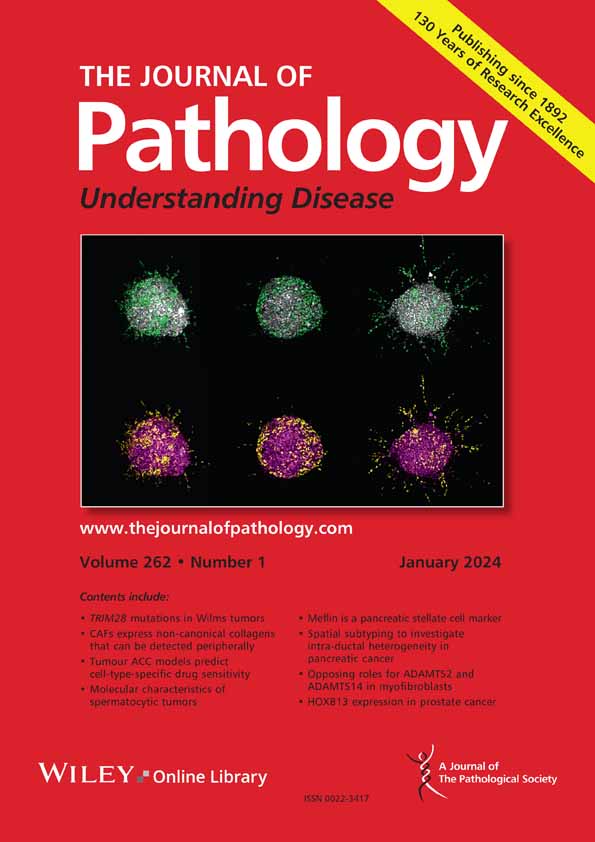Khoa A Nguyen, Lauren E McLemore, Yao Ke, Lisa N DePledge, Lynelle P Smith, Li Bian, John D Aleman, David Debretsion, Erica Wong, Nicole Manning, Xiao-Jing Wang, Christian D Young
下载PDF
{"title":"在表达角蛋白15的小鼠乳腺细胞中激活PI3K和缺失p53可诱导肿瘤异质性和可塑性模型化乳腺癌。","authors":"Khoa A Nguyen, Lauren E McLemore, Yao Ke, Lisa N DePledge, Lynelle P Smith, Li Bian, John D Aleman, David Debretsion, Erica Wong, Nicole Manning, Xiao-Jing Wang, Christian D Young","doi":"10.1002/path.6463","DOIUrl":null,"url":null,"abstract":"<p>Although relatively rare, metaplastic breast cancer responds poorly to traditional therapies compared to other subtypes. Accordingly, there is a need for novel animal models to understand its pathogenesis and plasticity. Since alterations in <i>PIK3CA</i> and <i>TP53</i> genes are common in metaplastic breast cancer, we generated a mouse model of metaplastic breast cancer by driving <i>Pik3ca</i> activation and <i>Trp53</i> loss in keratin 15-expressing mammary cells. In this model, male and female mice developed spontaneous mammary lesions, with malignancy reliant on loss of both <i>Trp53</i> alleles. Importantly, tumors of this model are heterogeneous and resemble the mixed histology of metaplastic breast cancer by exhibiting squamous cell carcinoma, carcinosarcoma, and sarcoma features. We developed mammary cell lines from mouse tumors representing these different histological subtypes. These <i>Pik3ca</i>-activated tumor cells were more sensitive to alpelisib, a p110α-selective inhibitor approved by the FDA for the treatment of some <i>PIK3CA</i> mutant cancers, compared to <i>Pik3ca</i> WT cells. Additionally, some of these cell lines expressed the androgen receptor, a hormone receptor targeted in prostate cancer and currently under investigation as a therapeutic target in breast cancer. Transplantation of these cell lines into recipient mice maintained histological heterogeneity. Additionally, transplantation of either Epcam+ or Epcam− sorted cells, representing epithelial cell-like and nonepithelial cell-like, respectively, from a carcinosarcoma cell line, initiated tumor formation. Both sorted populations formed tumors with mixed histologic features, demonstrating plasticity arising from different tumor-initiating components. These new models of metaplastic breast cancer from relevant genetic drivers serve as a platform for identifying mechanisms driving plasticity that could inform therapeutic strategies based on histology and reveal how plasticity alters treatment efficacy. © 2025 The Author(s). <i>The Journal of Pathology</i> published by John Wiley & Sons Ltd on behalf of The Pathological Society of Great Britain and Ireland.</p>","PeriodicalId":232,"journal":{"name":"The Journal of Pathology","volume":"267 2","pages":"213-224"},"PeriodicalIF":5.2000,"publicationDate":"2025-08-13","publicationTypes":"Journal Article","fieldsOfStudy":null,"isOpenAccess":false,"openAccessPdf":"https://www.ncbi.nlm.nih.gov/pmc/articles/PMC12438019/pdf/","citationCount":"0","resultStr":"{\"title\":\"Activation of PI3K and deletion of p53 in keratin 15-expressing mouse mammary cells induces tumor heterogeneity and plasticity modeling metaplastic breast cancer\",\"authors\":\"Khoa A Nguyen, Lauren E McLemore, Yao Ke, Lisa N DePledge, Lynelle P Smith, Li Bian, John D Aleman, David Debretsion, Erica Wong, Nicole Manning, Xiao-Jing Wang, Christian D Young\",\"doi\":\"10.1002/path.6463\",\"DOIUrl\":null,\"url\":null,\"abstract\":\"<p>Although relatively rare, metaplastic breast cancer responds poorly to traditional therapies compared to other subtypes. Accordingly, there is a need for novel animal models to understand its pathogenesis and plasticity. Since alterations in <i>PIK3CA</i> and <i>TP53</i> genes are common in metaplastic breast cancer, we generated a mouse model of metaplastic breast cancer by driving <i>Pik3ca</i> activation and <i>Trp53</i> loss in keratin 15-expressing mammary cells. In this model, male and female mice developed spontaneous mammary lesions, with malignancy reliant on loss of both <i>Trp53</i> alleles. Importantly, tumors of this model are heterogeneous and resemble the mixed histology of metaplastic breast cancer by exhibiting squamous cell carcinoma, carcinosarcoma, and sarcoma features. We developed mammary cell lines from mouse tumors representing these different histological subtypes. These <i>Pik3ca</i>-activated tumor cells were more sensitive to alpelisib, a p110α-selective inhibitor approved by the FDA for the treatment of some <i>PIK3CA</i> mutant cancers, compared to <i>Pik3ca</i> WT cells. Additionally, some of these cell lines expressed the androgen receptor, a hormone receptor targeted in prostate cancer and currently under investigation as a therapeutic target in breast cancer. Transplantation of these cell lines into recipient mice maintained histological heterogeneity. Additionally, transplantation of either Epcam+ or Epcam− sorted cells, representing epithelial cell-like and nonepithelial cell-like, respectively, from a carcinosarcoma cell line, initiated tumor formation. Both sorted populations formed tumors with mixed histologic features, demonstrating plasticity arising from different tumor-initiating components. These new models of metaplastic breast cancer from relevant genetic drivers serve as a platform for identifying mechanisms driving plasticity that could inform therapeutic strategies based on histology and reveal how plasticity alters treatment efficacy. © 2025 The Author(s). <i>The Journal of Pathology</i> published by John Wiley & Sons Ltd on behalf of The Pathological Society of Great Britain and Ireland.</p>\",\"PeriodicalId\":232,\"journal\":{\"name\":\"The Journal of Pathology\",\"volume\":\"267 2\",\"pages\":\"213-224\"},\"PeriodicalIF\":5.2000,\"publicationDate\":\"2025-08-13\",\"publicationTypes\":\"Journal Article\",\"fieldsOfStudy\":null,\"isOpenAccess\":false,\"openAccessPdf\":\"https://www.ncbi.nlm.nih.gov/pmc/articles/PMC12438019/pdf/\",\"citationCount\":\"0\",\"resultStr\":null,\"platform\":\"Semanticscholar\",\"paperid\":null,\"PeriodicalName\":\"The Journal of Pathology\",\"FirstCategoryId\":\"3\",\"ListUrlMain\":\"https://pathsocjournals.onlinelibrary.wiley.com/doi/10.1002/path.6463\",\"RegionNum\":2,\"RegionCategory\":\"医学\",\"ArticlePicture\":[],\"TitleCN\":null,\"AbstractTextCN\":null,\"PMCID\":null,\"EPubDate\":\"\",\"PubModel\":\"\",\"JCR\":\"Q1\",\"JCRName\":\"ONCOLOGY\",\"Score\":null,\"Total\":0}","platform":"Semanticscholar","paperid":null,"PeriodicalName":"The Journal of Pathology","FirstCategoryId":"3","ListUrlMain":"https://pathsocjournals.onlinelibrary.wiley.com/doi/10.1002/path.6463","RegionNum":2,"RegionCategory":"医学","ArticlePicture":[],"TitleCN":null,"AbstractTextCN":null,"PMCID":null,"EPubDate":"","PubModel":"","JCR":"Q1","JCRName":"ONCOLOGY","Score":null,"Total":0}
引用次数: 0
引用
批量引用





 求助内容:
求助内容: 应助结果提醒方式:
应助结果提醒方式:


